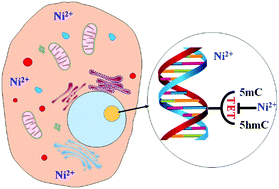当前位置:
X-MOL 学术
›
Metallomics
›
论文详情
Our official English website, www.x-mol.net, welcomes your feedback! (Note: you will need to create a separate account there.)
Nickel(ii) inhibits the oxidation of DNA 5-methylcytosine in mammalian somatic cells and embryonic stem cells
Metallomics ( IF 3.4 ) Pub Date : 2018-03-02 00:00:00 , DOI: 10.1039/c7mt00346c Ruichuan Yin 1, 2, 3, 4, 5 , Jiezhen Mo 1, 2, 3, 4, 5 , Jiayin Dai 3, 5, 6, 7, 8 , Hailin Wang 1, 2, 3, 4, 5
Metallomics ( IF 3.4 ) Pub Date : 2018-03-02 00:00:00 , DOI: 10.1039/c7mt00346c Ruichuan Yin 1, 2, 3, 4, 5 , Jiezhen Mo 1, 2, 3, 4, 5 , Jiayin Dai 3, 5, 6, 7, 8 , Hailin Wang 1, 2, 3, 4, 5
Affiliation

|
Nickel is found widely in the environment. It is an essential microelement but also toxic. However, nickel displays only weak genotoxicity and mutagenicity. Exploration of the epigenetic toxicity of nickel is extremely interesting. Iron(II)- and 2-oxoglutarate-dependent Tet dioxygenases are a class of epigenetic enzymes that catalyze the oxidation of DNA 5-methylcytosine (5mC). Thus, they are critical for DNA demethylation and, importantly, are involved with nuclear reprogramming, embryonic development, and regulation of gene expression. Here, we demonstrated that nickel(II) dramatically inhibits Tet proteins-mediated oxidation of DNA 5mC in cells ranging from somatic cell lines to embryonic stem cells, as manifested by the consistent observation of a significant decrease in 5-hydroxymethylcytosine, a critical intermediate resulting from the oxidation of 5mC. The inhibitory effects of nickel(II) were concentration- and time-dependent. Using HEK293T cells overexpressing Tet proteins and ascorbic acid-stimulated Tet-proficient ES cells, we observed that nickel(II) significantly reduced DNA demethylation at the global level. Interestingly, we also showed that nickel(II) might affect the naïve or ground state of pluripotent embryonic stem cells. Here we show, for the first time, that nickel(II) represses the oxidation of DNA 5mC and potentially alters the Tet proteins-regulated DNA methylation landscape in human cells. These findings provide new insights into the epigenetic toxicology of nickel.
中文翻译:

镍(ii)抑制哺乳动物体细胞和胚胎干细胞中DNA 5-甲基胞嘧啶的氧化
镍广泛存在于环境中。它是必不可少的微量元素,但也是有毒的。但是,镍仅显示出弱的遗传毒性和诱变性。探索镍的表观遗传毒性非常有趣。依赖铁(II)和2-氧戊二酸的Tet双加氧酶是一类表观遗传酶,可催化DNA 5-甲基胞嘧啶(5mC)的氧化。因此,它们对于DNA脱甲基至关重要,并且很重要的是,它们与核重编程,胚胎发育以及基因表达的调控有关。在这里,我们证明了镍(II)广泛抑制从体细胞系到胚胎干细胞的细胞中Tet蛋白介导的DNA 5mC的氧化,这一直被观察到,5-羟甲基胞嘧啶是5mC氧化产生的关键中间体,5-羟甲基胞嘧啶的显着减少一直被观察到。镍(II)的抑制作用与浓度和时间有关。使用过表达Tet蛋白的HEK293T细胞和抗坏血酸刺激的Tet精通的ES细胞,我们观察到镍(II)在全球范围内显着减少了DNA脱甲基。有趣的是,我们还表明,镍(II)可能会影响多能胚胎干细胞的幼稚或基态。在这里,我们首次展示了镍(II)抑制5mC DNA的氧化,并可能改变人细胞中Tet蛋白调节的DNA甲基化态势。这些发现为镍的表观遗传学毒理学提供了新的见解。
更新日期:2018-03-02
中文翻译:

镍(ii)抑制哺乳动物体细胞和胚胎干细胞中DNA 5-甲基胞嘧啶的氧化
镍广泛存在于环境中。它是必不可少的微量元素,但也是有毒的。但是,镍仅显示出弱的遗传毒性和诱变性。探索镍的表观遗传毒性非常有趣。依赖铁(II)和2-氧戊二酸的Tet双加氧酶是一类表观遗传酶,可催化DNA 5-甲基胞嘧啶(5mC)的氧化。因此,它们对于DNA脱甲基至关重要,并且很重要的是,它们与核重编程,胚胎发育以及基因表达的调控有关。在这里,我们证明了镍(II)广泛抑制从体细胞系到胚胎干细胞的细胞中Tet蛋白介导的DNA 5mC的氧化,这一直被观察到,5-羟甲基胞嘧啶是5mC氧化产生的关键中间体,5-羟甲基胞嘧啶的显着减少一直被观察到。镍(II)的抑制作用与浓度和时间有关。使用过表达Tet蛋白的HEK293T细胞和抗坏血酸刺激的Tet精通的ES细胞,我们观察到镍(II)在全球范围内显着减少了DNA脱甲基。有趣的是,我们还表明,镍(II)可能会影响多能胚胎干细胞的幼稚或基态。在这里,我们首次展示了镍(II)抑制5mC DNA的氧化,并可能改变人细胞中Tet蛋白调节的DNA甲基化态势。这些发现为镍的表观遗传学毒理学提供了新的见解。



























 京公网安备 11010802027423号
京公网安备 11010802027423号